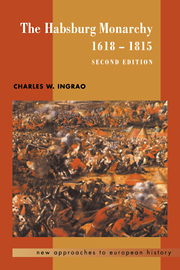Book contents
- Frontmatter
- Contents
- List of maps
- Genealogical tables
- Preface
- 1 The distinctiveness of Austrian history
- 2 The Thirty Years' War (1618–1648)
- 3 Facing east: Hungary and the Turks (1648–1699)
- 4 Facing west: the second Habsburg empire (1700–1740)
- 5 The Prussian challenge: war and government reform (1740–1763)
- 6 Discovering the people: the triumph of cameralism and enlightened absolutism (1765–1792)
- 7 The age of revolution (1789–1815)
- 8 Decline or disaggregation?
- Bibliography
- Index
- More titles in the NEW APPROACHES TO EUROPEAN HISTORY series
4 - Facing west: the second Habsburg empire (1700–1740)
- Frontmatter
- Contents
- List of maps
- Genealogical tables
- Preface
- 1 The distinctiveness of Austrian history
- 2 The Thirty Years' War (1618–1648)
- 3 Facing east: Hungary and the Turks (1648–1699)
- 4 Facing west: the second Habsburg empire (1700–1740)
- 5 The Prussian challenge: war and government reform (1740–1763)
- 6 Discovering the people: the triumph of cameralism and enlightened absolutism (1765–1792)
- 7 The age of revolution (1789–1815)
- 8 Decline or disaggregation?
- Bibliography
- Index
- More titles in the NEW APPROACHES TO EUROPEAN HISTORY series
Summary
The European powers had been preparing for Charles II's death for his entire thirty-five-year reign. Finally, at the end of the century unmistakable signs of his imminent demise encouraged a rash of diplomatic activity. Although the Austrian Habsburgs and French Bourbons were the main antagonists, all of the major, and several smaller, countries had a stake in the succession struggle. There were, in fact, initially three claims to Charles's inheritance, all based on the rights of Charles's two sisters. As the husband of the elder Maria Theresa, Louis XIV could put forward a claim on behalf of the Grand Dauphin and his three sons, especially since the Spanish government had never paid France the 500,000 crowns in compensation for renouncing its rights to the inheritance. Although Emperor Leopold had married the younger Margaret Theresa, their only surviving child was a daughter, Maria Antonia. Before her death in 1692, the archduchess had married Max Emanuel and borne a son, Joseph Ferdinand, whose rights the Bavarian elector now advanced. Leopold asserted his own rights as Margaret Theresa's widower, but his position as the head of the younger male Habsburg line gave him his strongest claim, especially in those parts of the Spanish empire where the laws of succession discounted the rights of female heirs. Moreover, as the father of two healthy sons, Leopold enjoyed the luxury of promoting the candidacy of the younger Archduke Charles, while the elder Archduke Joseph would rule the Austrian Habsburg monarchy after his death (see Genealogical Table on p. ix).
- Type
- Chapter
- Information
- The Habsburg Monarchy, 1618–1815 , pp. 105 - 149Publisher: Cambridge University PressPrint publication year: 2000



